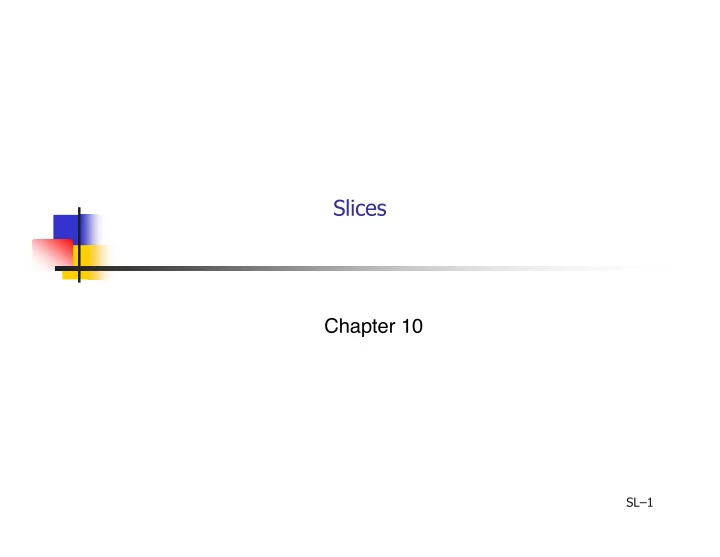

Slices Chapter 10 SL–1
Program slice What is a program slice? SL–2
Program slice – Informally What is a program slice? A program slice is a set of program statements that contributes to or affects the value of a variable at some point in a program SL–3
Program slice – Formally What is a program slice? Given a program P and a set of variables V in P and a statement or statement fragment n A slice S(V, n) is A set of node numbers in a program graph The set of all statements and statement fragments in P prior to the node n that contribute to the values of variables in V at node n. Prior to is a dynamic execution time notion SL–4
Program slice – Point of Analyze a program by focusing on parts of interest, disregarding uninteresting parts The point of slices is to separate a program into components that have a useful functional meaning Ignore those parts that do not contribute to the functional meaning of interest Cannot do this with du-paths, as slices are not simply sequences of statements or statement fragments SL–5
Program slice – meaning of "contributes to" Refine the meaning of usage and defining nodes P-use – used in a decision predicate C-use – used in a computation O-use – used for output L-use – used for location (pointers, subscripts) I-use – used for iteration (loop counters, loop indices) I-def – defined by input A-def – defined by assignment Textbook excludes all non-executable statements such as variable declarations SL–6
Program slide – meaning of "contributes to" – 2 What to include in S(V,n)? Consider a single variable v Include all I-def, A-def Include any C-use, P-use of v, if excluding it would change the value of v Include any P-use or C-use of another variable, if excluding it would change the value of v SL–7
Program slide – meaning of "contributes to" – 3 What to include in S(V,n)? Consider a single variable v L-use and I-use Inclusion is a judgment call, as such use does cause problems Exclude all non-executable nodes such as variable declarations If a slice is not to be compliable Exclude O-use, as does not change the value of v SL–8
Example 1 – program An A-def of j 1 int max = 0; 2 int j = s.nextInt(); 3 while (j > 0) An A-def of max P-uses of j & max 4 if (j > max) { A C-use of j 5 max = j; 6 } 7 j = s.nextInt(); An O-use of max An A-def of j 8 } 9 System.out.println(max); SL–9
Example 1 – some slices This not an exciting program wrt to slices S ( max , 9 ) = { 1, 4, 5, 9 } S ( max , 9 ) = { 1, 2, 3, 4, 5, 6, 7, 8, 9 } S ( max , 5 ) = { 1, 4, 5, 6, 8 } S ( max , 5 ) = { 1, 2, 3, 4, 5, 6, 7, 8 } S ( j , 7 ) = { 2, 3, 4, 5 6, 7, 8 } S ( j , 5 ) = {1, 2, 3, 4, 5, 6, 7, 8} SL–10
Slice style & technique Make slices on one variable Sometimes slices with more variables are trivial super sets of a one variable case, then a slice on many variables is useful Do not make a slice S(V, n) where the variables of interest are not in node n Leads to slices that are too big SL–11
Slice style & technique – 2 Make slices for all A-def nodes Make slices for all P-def nodes Very useful in decision intensive programs Try to make slices compliable Means including declarations and compiler directives Such slices become executable and more easily tested SL–12
Slice style & technique – 3 Avoid slices on C-use They tend to be redundant Avoid slices on O-use They are the union of all the A-def and I-def slices Dramatically increase test effort SL–13
Slice style & technique – 4 Relative complement of slices can have diagnostic value If you have difficulty at a part, divide the program into two parts If the error does not lie in one part, then it must be in the relative complement Slices contain define/reference information When two slices are the same set, the corresponding paths are definition clear SL–14
Slice style & technique – 5 Slices and DD-paths have a many-to-many relationship Nodes in one slice may be in many DD-paths, and nodes in one DD-path may be in many slices Sometimes well-chosen relative complement slices can be identical to DD-paths Developing a lattice of slices can improve insight in potential trouble spots SL–15
Lattice What is a lattice? SL–16
Lattice – 2 What is a lattice? A directed acyclic graph Shows "contained-in" relationships See Figures 10.4 & 10.5 SL–17
Slices and programming practice Recall Bezier level 4 Slice testing is an example where consideration of testing can lead to better program development Build and test a program in slices Merge / splice slices into larger programs Use slice composition to re-develop difficult sections of program text SL–18
Recommend
More recommend